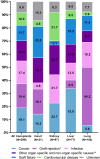Trends in underlying causes of death in solid organ transplant recipients between 2010 and 2020: Using the CLASS method for determining specific causes of death
- PMID: 35877606
- PMCID: PMC9312393
- DOI: 10.1371/journal.pone.0263210
Trends in underlying causes of death in solid organ transplant recipients between 2010 and 2020: Using the CLASS method for determining specific causes of death
Abstract
Monitoring specific underlying causes of death in solid organ transplant (SOT) recipients is important in order to identify emerging trends and health challenges. This retrospective cohort study includes all SOT recipients transplanted at Rigshospitalet between January 1st, 2010 and December 31st, 2019. The underlying cause of death was determined using the newly developed Classification of Death Causes after Transplantation (CLASS) method. Cox regression analyses assessed risk factors for all-cause and cause-specific mortality. Of the 1774 SOT recipients included, 299 patients died during a total of 7511 person-years of follow-up (PYFU) with cancer (N = 57, 19%), graft rejection (N = 55, 18%) and infections (N = 52, 17%) being the most frequent causes of death. We observed a lower risk of all-cause death with increasing transplant calendar year (HR 0.91, 95% CI 0.86-0.96 per 1-year increase), alongside death from graft rejection (HR 0.84 per year, 95% CI 0.74-0.95) and death from infections (HR 0.86 per year, 95% CI 0.77-0.97). Further, there was a trend towards lower cumulative incidence of death from cardiovascular disease, graft failure and cancer in more recent years, while death from other organ specific and non-organ specific causes did not decrease. All-cause mortality among SOT recipients has decreased over the past decade, mainly due to a decrease in graft rejection- and infection-related deaths. Conversely, deaths from a broad range of other causes have remained unchanged, suggesting that cause of death among SOT recipients is increasingly diverse and warrants a multidisciplinary effort and attention in the future.
Conflict of interest statement
The authors have declared that no competing interests exist.
Figures



References
-
- Lund LH, Khush KK, Cherikh WS, Goldfarb S, Kucheryavaya AY, Levvey BJ, et al.. The Registry of the International Society for Heart and Lung Transplantation: Thirty-fourth Adult Heart Transplantation Report-2017; Focus Theme: Allograft ischemic time. J Heart Lung Transplant. 2017;36(10):1037–46. Epub 2017/08/07. doi: 10.1016/j.healun.2017.07.019 . - DOI - PubMed
-
- Chambers DC, Cherikh WS, Harhay MO, Hayes D Jr., Hsich E, Khush KK, et al.. The International Thoracic Organ Transplant Registry of the International Society for Heart and Lung Transplantation: Thirty-sixth adult lung and heart-lung transplantation Report-2019; Focus theme: Donor and recipient size match. J Heart Lung Transplant. 2019;38(10):1042–55. Epub 2019/09/25. doi: 10.1016/j.healun.2019.08.001 . - DOI - PMC - PubMed
-
- Atabani SF, Smith C, Atkinson C, Aldridge RW, Rodriguez-Perálvarez M, Rolando N, et al.. Cytomegalovirus replication kinetics in solid organ transplant recipients managed by preemptive therapy. Am J Transplant. 2012;12(9):2457–64. Epub 2012/05/19. doi: 10.1111/j.1600-6143.2012.04087.x . - DOI - PMC - PubMed
Publication types
MeSH terms
LinkOut - more resources
Full Text Sources
Medical
Miscellaneous

